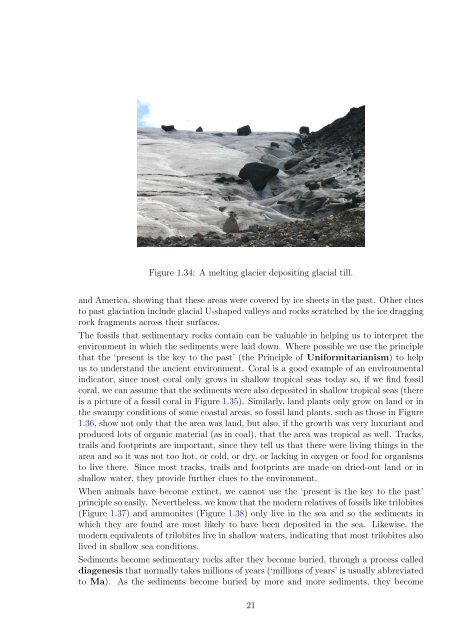The planet we live on: The beginnings of the Earth Sciences
The planet we live on: The beginnings of the Earth Sciences
The planet we live on: The beginnings of the Earth Sciences
- No tags were found...
You also want an ePaper? Increase the reach of your titles
YUMPU automatically turns print PDFs into web optimized ePapers that Google loves.
Figure 1.34: A melting glacier depositing glacial till.and America, showing that <strong>the</strong>se areas <str<strong>on</strong>g>we</str<strong>on</strong>g>re covered by ice sheets in <strong>the</strong> past. O<strong>the</strong>r cluesto past glaciati<strong>on</strong> include glacial U-shaped valleys and rocks scratched by <strong>the</strong> ice draggingrock fragments across <strong>the</strong>ir surfaces.<str<strong>on</strong>g>The</str<strong>on</strong>g> fossils that sedimentary rocks c<strong>on</strong>tain can be valuable in helping us to interpret <strong>the</strong>envir<strong>on</strong>ment in which <strong>the</strong> sediments <str<strong>on</strong>g>we</str<strong>on</strong>g>re laid down. Where possible <str<strong>on</strong>g>we</str<strong>on</strong>g> use <strong>the</strong> principlethat <strong>the</strong> ‘present is <strong>the</strong> key to <strong>the</strong> past’ (<strong>the</strong> Principle <strong>of</strong> Uniformitarianism) to helpus to understand <strong>the</strong> ancient envir<strong>on</strong>ment. Coral is a good example <strong>of</strong> an envir<strong>on</strong>mentalindicator, since most coral <strong>on</strong>ly grows in shallow tropical seas today so, if <str<strong>on</strong>g>we</str<strong>on</strong>g> find fossilcoral, <str<strong>on</strong>g>we</str<strong>on</strong>g> can assume that <strong>the</strong> sediments <str<strong>on</strong>g>we</str<strong>on</strong>g>re also deposited in shallow tropical seas (<strong>the</strong>reis a picture <strong>of</strong> a fossil coral in Figure 1.35). Similarly, land plants <strong>on</strong>ly grow <strong>on</strong> land or in<strong>the</strong> swampy c<strong>on</strong>diti<strong>on</strong>s <strong>of</strong> some coastal areas, so fossil land plants, such as those in Figure1.36, show not <strong>on</strong>ly that <strong>the</strong> area was land, but also, if <strong>the</strong> growth was very luxuriant andproduced lots <strong>of</strong> organic material (as in coal), that <strong>the</strong> area was tropical as <str<strong>on</strong>g>we</str<strong>on</strong>g>ll. Tracks,trails and footprints are important, since <strong>the</strong>y tell us that <strong>the</strong>re <str<strong>on</strong>g>we</str<strong>on</strong>g>re living things in <strong>the</strong>area and so it was not too hot, or cold, or dry, or lacking in oxygen or food for organismsto <str<strong>on</strong>g>live</str<strong>on</strong>g> <strong>the</strong>re. Since most tracks, trails and footprints are made <strong>on</strong> dried-out land or inshallow water, <strong>the</strong>y provide fur<strong>the</strong>r clues to <strong>the</strong> envir<strong>on</strong>ment.When animals have become extinct, <str<strong>on</strong>g>we</str<strong>on</strong>g> cannot use <strong>the</strong> ‘present is <strong>the</strong> key to <strong>the</strong> past’principle so easily. Never<strong>the</strong>less, <str<strong>on</strong>g>we</str<strong>on</strong>g> know that <strong>the</strong> modern relatives <strong>of</strong> fossils like trilobites(Figure 1.37) and amm<strong>on</strong>ites (Figure 1.38) <strong>on</strong>ly <str<strong>on</strong>g>live</str<strong>on</strong>g> in <strong>the</strong> sea and so <strong>the</strong> sediments inwhich <strong>the</strong>y are found are most likely to have been deposited in <strong>the</strong> sea. Likewise, <strong>the</strong>modern equivalents <strong>of</strong> trilobites <str<strong>on</strong>g>live</str<strong>on</strong>g> in shallow waters, indicating that most trilobites also<str<strong>on</strong>g>live</str<strong>on</strong>g>d in shallow sea c<strong>on</strong>diti<strong>on</strong>s.Sediments become sedimentary rocks after <strong>the</strong>y become buried, through a process calleddiagenesis that normally takes milli<strong>on</strong>s <strong>of</strong> years (‘milli<strong>on</strong>s <strong>of</strong> years’ is usually abbreviatedto Ma). As <strong>the</strong> sediments become buried by more and more sediments, <strong>the</strong>y become21
















